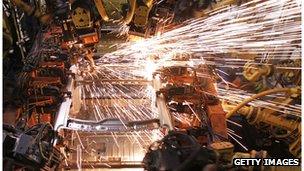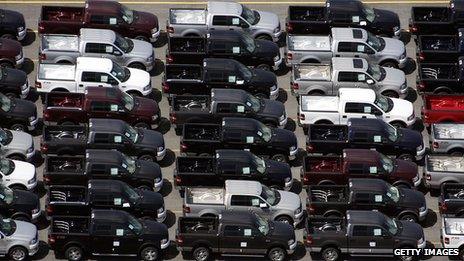What does the future hold for American manufacturing?
- Published
- comments

The state of US manufacturing is likely to become a major campaign issue
Drew Greenblatt is an enthusiast: proud of his company, Marlin Steel, and proud of the factory floor packed with state-of-the-art equipment.
I watch, fascinated, as a little white robot squeezes out a wire, putting kinks and bends in it as it emerges.
Then it hands it over to a slightly larger yellow robot, which holds it steady for a twist in the end before turning it over for another twist at the other end.
Oddly, I find this cutting-edge equipment rather cute and cartoonish.
The question is whether this endearing duo are merely the remnants of America's industrial past or the sort of equipment that will make the USA world-beaters once again.
The factory floor space at Marlin Steel is being doubled and there is no doubt the company is doing well, prospering even, during the bad years.
They started off making wire baskets for bagels years ago, but now make specialised wire baskets for industrial processes.
They sell to Boeing and Toyota. One basket I watch being made is destined for China's telecom industry.
Mr Greenblatt tells me: "Since 2005 we've grown 118%. Last year we grew 20%, we're looking to employ more people. We're very bullish."
This is part of a trend reflected in recent figures. Manufacturers do see an improvement in the economy.
Chris Elwood's card has him down as "mechanical engineer" for Marlin, but he handles half of all the company's sales.
He says: "Over the last three months I have seen a rebound. Now, Marlin's growth was pretty steady eddy over the last few years, but over the last three months I've seen a pick-up in ordering and quicker decision-making by the decision-makers I talk to every day.
"What used to take three months seems to be getting pushed through in a matter of days. There was a lot of trepidation before. A lot of humming and hawing when you are trying to win the contract. That's not as prevalent now."
The manufacturing industry will be centre stage in November's election.
US President Barack Obama has just come up with an idea to cut corporation tax and set a lower rate for the manufacturing industry. It is just one component of his push for a renaissance in American manufacturing.
There are a growing number of economists who think this makes sound sense, external. They say that without a vibrant manufacturing sector the USA will not stay ahead.
While it only makes up about 11% of America's GDP, it accounts for two thirds, external of its research and development spending.
More importantly politically is the argument that it was the higher wages in manufacturing that originally pushed America's blue collar workers into prosperity.
But its decline meant they borrowed and went into debt to maintain their standard of living.
If you accept this argument, the decline in manufacturing is responsible in large part for the financial crisis.
Mr Greenblatt agrees: "The average manufacturer in America has an employee who is being paid $77,000 (£49,000) a year. That's a nice living.
"You can own a home in America that way, a pair of cars, one for you and one for your spouse. You can take a vacation, send your kid to college."
As he shows me around the factory it is clear that Drew Greenblatt is also an enthusiast for globalisation.
He points out one machine imported from Surrey, in England, another from France, a third from South Africa.
They make goods which are exported to 38 countries in Asia, Europe and South America.
Some say it is very hard for American companies to compete.
Alan Tonelson of the US business and industry council says: "There's an enormous trade policy problem. US trade policy has pushed way too many US manufacturing jobs overseas.
"It has done that by opening the US market to production from companies where businesses face none of the tax and regulatory burdens that US businesses face."
He says the foreign-based companies have a completely unfair advantage.
"Not only fewer regulations, there are no regulations. There are not only lower labour costs but rock bottom labour costs.
"Not only lower tax burdens but absolutely no tax burdens, and in fact often massive subsidies for not only manufacturing but exporting itself."
To Mr Tonelson, some form of protectionism is the only answer.
Mr Greenblatt profoundly disagrees. He says his company can compete because of speed of delivery, superior engineering skills making tailor-made products and high precision equipment.
But Mr Tonelson goes on to argue that the recovery, in manufacturing and elsewhere, could be short-lived when the stimulus money runs out.
"What is not widely realised is that if there has been a manufacturing rebound in recent months it looks like it is over because manufacturing grew at a slower pace in 2011 than 2010.
"Overall manufacturing is back at levels we first hit in the year 2000, so it is very fair to conclude we've had a lost decade for US manufacturing.
"Given the fact that these levels of government stimulus, these growth steroids cannot possibly continue, I cannot anticipate a very favourable outlook for manufacturing going forward."
At Marlin Steel two giant stars-and-stripes flags hang above the heads of the workers, industrial robots and laser cutters.
The words "Made in America" make patriotic hearts swell. There's now a debate about whether they are sound policy as well as sentiment.
- Published15 February 2012
